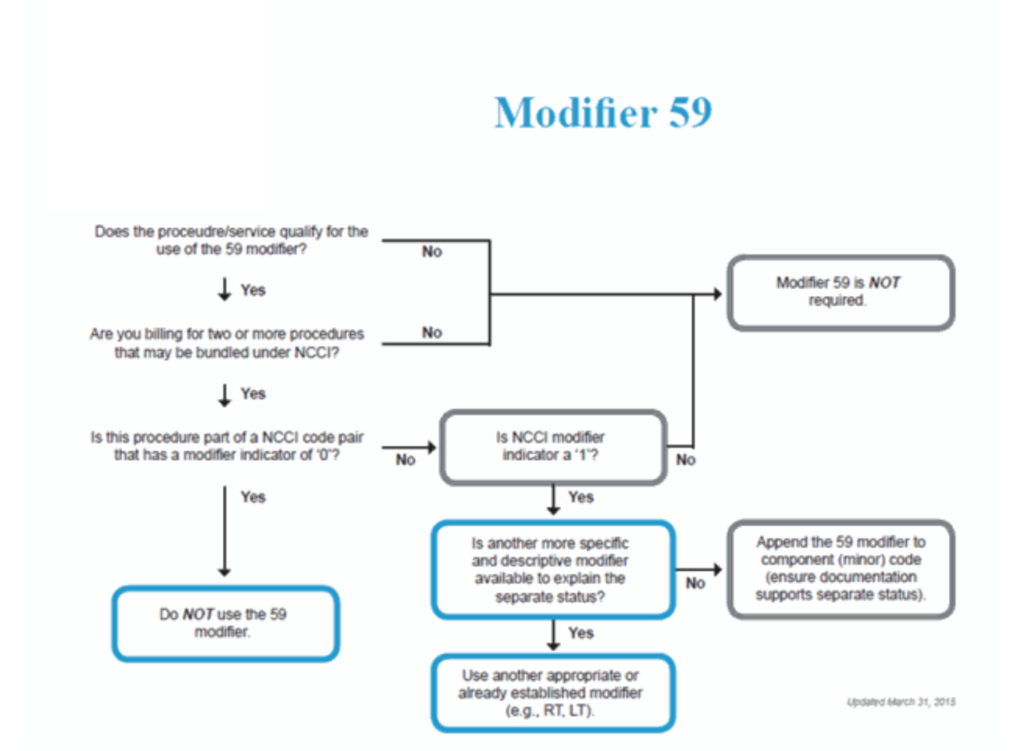
Modifier 59 CPT Code are a number of commercial payers, including Anthem, Aetna, and Humana, adopted front-end claim edit policies for claims containing these modifiers in response to multiple announcements from CMS that providers were abusing modifier 59 vs 25 as a way to bypass edit pairs without providing adequate documentation to support those bypasses. The problems with modifier 59 denials for claims numbers 97530 and 97140 have been rectified by Aetna and Humana, however Anthem has not yet revised its policies. Where are doctors making mistakes when coding for Anthem patients, and how can you prevent modifier 59 description with example CPT Code denials in your own practise using examples for 97530 and 97140? What you should know is as follows.
What is the history of the 97530 and 97140 Modifier 59 CPT Code denials?
In March 2020, CMS added the X sub-modifiers to a CMS policy document that has since been revoked. The xs modifier examples is used to represent 2 procedures performed in the same encounter, but on different organs or structures. For dermatologists, this would mainly be used to indicate different anatomic locations on the skin. CMS cited 97140 (manual treatment) and 97530 (therapeutic activities) in that document and made the following clear:
If the two procedures are carried out in clearly distinct 15-minute time blocks, Modifier 59 CPT Code may be reported. For instance, one service might be provided during the first 15 minutes of therapy and another during the next 15 minutes.
It is also possible to separate the blocks of therapy time. By way of illustration, 10 minutes of manual treatment may be followed by 15 minutes of therapeutic exercises and then 5 minutes of manual therapy.
59 Modifier Physical Therapy 2022 was only to be used, in other words, “when two timed procedures are performed in different blocks of time on the same day.” The codes exempt from modifier 51 appendix is appropriate, thus there is no need to specify an X sub-modifier. Modifier 59 CPT Code should not be used with evaluation/management (E/M) services, and should not be used when there is a more descriptive modifier available.
However, CMS has since updated its Modifier 59 CPT Code and X-modifier policies to allow modifiers 59, XE, XS, XP, or XU to be used with Column 1 or Column 2 codes. Providers should not use Modifier 59 CPT Code, XE, XS, XP, or XU, or other NCCI PTP-associated modifiers, to avoid an NCCI procedure-to-procedure (PTP) edit “unless the proper criteria for use of the modifiers are met,” according to CMS, who also notes that “medical documentation must support the use of the modifier.”
How should I respond to appeals from commercial payer denials?
Aetna and Humana revised similar policies they had put in place regarding coding modifications and Modifier 59 CPT Code denials for 97530 and 97140 as a result of CMS’s policy reversal. Anthem however continues to argue that using the second column code (97530) is mutually exclusive, prompting providers to file an appeal and provide supporting documentation.
Your billing team should definitely file an appeal if you receive this kind of denial.You’ll need to provide evidence that you are properly employing Modifier 59 CPT Code and that you merit payment for both services. This means your documentation must include:
- The right grouping of interventions that correspond to each CPT code (e.g., all manual therapy innovations should be kept apart from any therapeutic activities).
- The overall amount of one-on-one treatment time in minutes, including the minutes spent on manual therapy and therapeutic activities.
- The body part involved in each intervention, as in many instances, is not useful to a reviewer when you call an exercise (such as dead bug or pendulum swings), as different practises may have different titles for the same exercise.
- The following sentence (or a variation of it): “The manual therapy interventions were performed at a separate and distinct time from the therapeutic activities interventions.”
What additional CPT codes are now accessible?
If you give interventions other than therapeutic activities (97530) while providing manual therapy (97140) during the same patient visit, you can also completely skip the edit. These treatments could entail neuromuscular reeducation (97112) or therapeutic exercise (97110). But you can’t just carry out a therapeutic exercise and call it a therapeutic exercise. Reviewers are specifically looking for this tactic because it would be false. Instead, you need to charge for the intervention intent that each code description specifies. Let’s look more closely at that intention.
97530: Therapeutic Activities
Definition: Direct (one-on-one) patient contact by the provider (use of dynamic activities to improve functional performance), every 15 minutes.
Key words here are “dynamic activities” and “functional performance.” Think of “dynamic” as “big” body movements or multi-segment movements. Think of “functional” as meaning “real-life” movements—like lifting, carrying, squatting, bending, jumping, and lunging.
97112: Neuromuscular Re-education
Definition: Neuromuscular re-education of movement, balance, coordination, kinesthetic sense, posture and proprioception for sitting and standing activities. Therapeutic procedure, one or more areas, every 15 minutes.
This code emphasizes specific feedback to the patient about the quality and/or specificity of instruction in movement, mechanics, posture, and balance, as well as facilitation/inhibition techniques and training in proprioception and desensitization.
97110: Therapeutic Exercises
Definition: Therapeutic exercises to develop strength, endurance, range of motion, and flexibility. Therapeutic procedure, one or more areas, every 15 minutes.
Granted, this is a vague definition, which makes it tempting to use this code for all movement interventions. And that’s exactly why it tends to be overused. Instead, only code for therapeutic exercise if the movement doesn’t meet the criteria for either therapeutic activity or neuromuscular reeducation. Active and passive range of motion, manual stretching, and most manual resistance exercises would correctly fall under this code.
Are there any upcoming changes to Anthem’s policies?
In order to reform the policies banning specific code pairs that, when implemented by private payers, led to a surplus of Modifier 59 CPT Code denials for 97530 and 97140, the APTA’s advocacy activities were essential. Humana and Aetna quickly followed suit and changed their claim edit policies as well, just as they did when they initially embraced CMS’s more onerous NCCI edit changes. Anthem, on the other hand, continues to be a holdout, which necessitates that providers challenge Anthem denials when the documentation does in fact support the use of the modification, and they support any attempts made by the APTA to pressure Anthem to alter their own policy.
There’s no question that the current Modifier 59 CPT Code situation is frustrating for PTs, but the best strategy to take at this point is this:
- Always code correctly based on the intent of each code, and
- Ensure that your documentation supports the unbundling of edit pairs whenever you use modifier 59.
Fast Billing Solutions is an excellent orginazition with its customized solutions offered to the doctors and the hospitals for their business operations needs nationwide. We have been able to help health care providers to increase their collections and profits by an average of 10-15 percent.
We has been a pioneer organization for medical billing & coding in US. We have been in medical billing & coding industry for over a decade now and provide highly experienced medical biller that help your healthcare practice to gain a competitive edge. Our medical biller & coder experts guarantee accuracy levels up to 98% at highly cost-effective prices and within a quick turnaround time. Contact us for more details.
To Book a Free Demo. click here
Read more: What is CPT Code and Why Use CPT 97116 code Medical Billing , All You Need to Know About J Code, HCC Coding & PT CPT Codes
